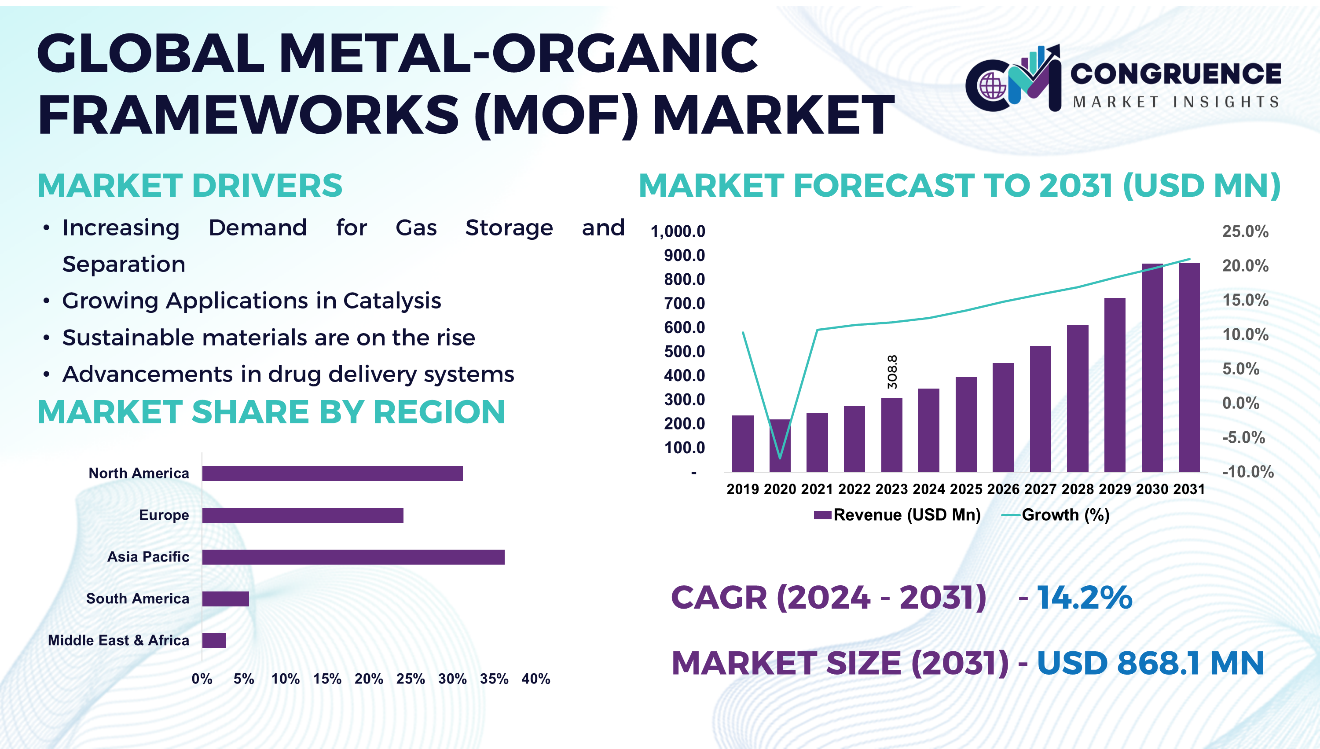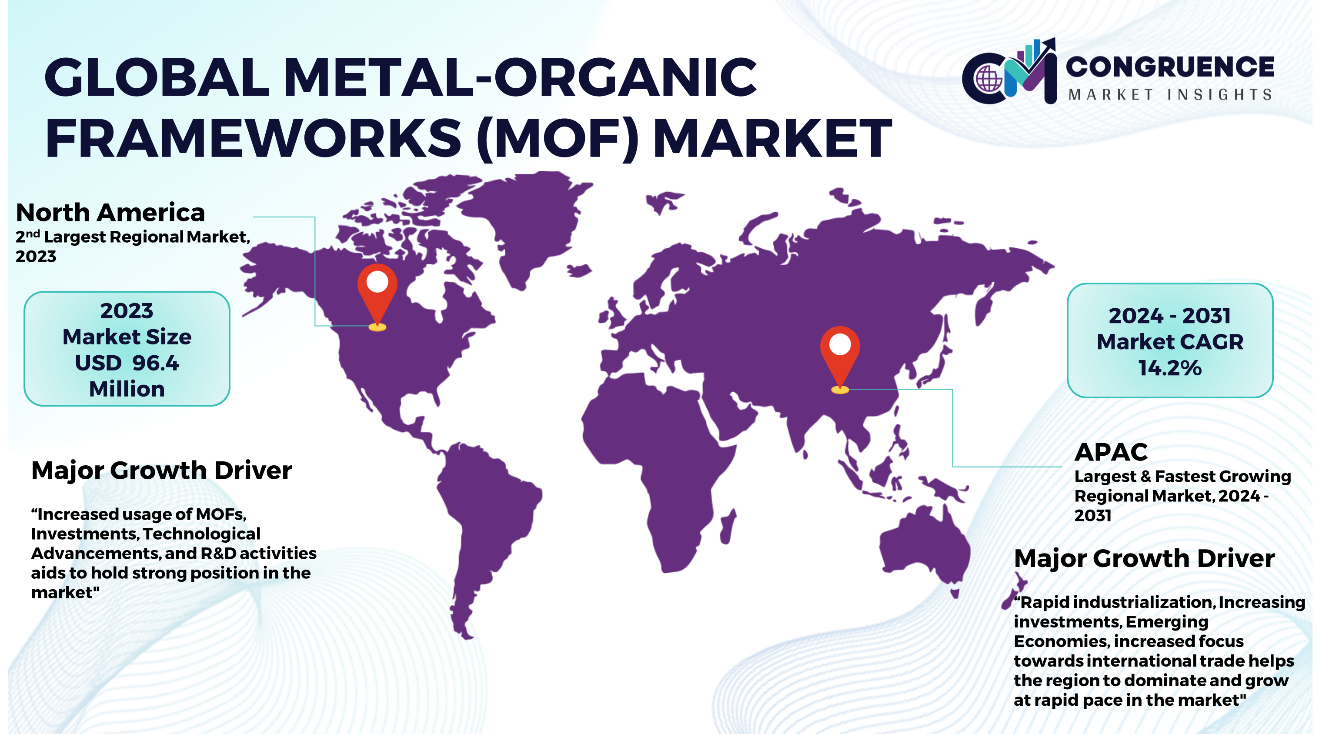Reports
The Global Metal-Organic Frameworks (MOF) Market was valued at USD 308.8 Million in 2023 and is anticipated to reach a value of USD 868.1 Million by 2031 expanding at a CAGR of 14.2% between 2024 and 2031.
Metal-Organic Frameworks (MOFs) are a class of porous materials composed of intricate three-dimensional structures from the linkage of metal ions or clusters with organic ligands. The synthesis usually occurs through a standard and precise process of solve thermal or hydrothermal synthesis, where metal precursors and organic ligands are mixed to initiate crystallization. MOFs are versatile, and applications are found across many industries. In the value chain, the suppliers offer raw materials, which are mainly in the form of metal ions and organic ligands. The manufacturers synthesize these to produce MOF products. Recent technological developments have focused on the improvement of stability and scalability of the production of MOF. Manufacturers can, therefore, design the MOF for specific applications like gas storage, catalysis, drug delivery, and chemical sensing. Technological developments have extended to the inclusion of new synthesis methods, such as microwave-assisted techniques and continuous flow reactors, which enable the production of tailored MOFs in an efficient manner. Current studies envision the application being extended to MOFs and finding ways to improve manufacturing processes according to the market demand.

Metal-Organic Frameworks (MOF) Market Major Driving Forces
Increasing Demand for Gas Storage and Separation: MOFs are highly sought after for their efficiency in storing and separating gases like hydrogen, methane, and carbon dioxide. Demand is being driven by the global shift toward sustainable energy solutions and the urgent need for mitigation from environmental impacts linked with gas emissions.
Growing Applications in Catalysis: Owing to their particular catalytic properties, MOFs attract a lot of interest in many industries, namely petrochemicals, pharmaceuticals, and fine chemicals. Strong chemical reactions with controlled amounts along with high surface area can exhibit a high efficiency and selectivity of the catalysts.
Sustainable materials are on the rise: MOFs could be counted among the sustainable materials as they are recyclable, their properties are tunable, and they are eco-friendly in a way that coincides with sustainability intentions and thus continually relates to the technological applications in all industries.
Advancements in drug delivery systems: MOFs stand poised to become one of the promising candidates for drug delivery systems as they encapsulate and release pharmaceuticals in a controlled manner. This innovation in healthcare would allow targeted delivery of drugs to improve therapeutic efficacy while holding back side effects.
Metal-Organic Frameworks (MOF) Market Key Opportunities
Sensor Technology: Integration offers opportunities for fast, selective, and precise sensing of gases, chemicals, and biomolecules that can contribute to the environment monitoring and diagnostics in health care.
Energy Storage and Conversion: In the areas of application in batteries and supercapacitors, MOFs show exciting potential for energy storage, while their derivatives have potential to catalyze energy conversion processes, such as the splitting of water or carbon capture.
Gas Storage and Separation: Current developments in MOF materials herald possibilities of further enhancing gas storage capacity and improving the selectivity in the gas separation application to find a solution to energy needs.
Catalysis and Chemical Processes: The tailored catalytic properties of MOFs open perspectives on optimizing chemical processes such as conversions, hydrogenation, and pollutant remediation, advanced in industrial and environmental applications.
Applications in drug delivery and biomedical aspects: Owing to its ability to encapsulate drugs and other active components, MOFs offer new solutions and aids for drug delivery systems, especially targeting therapies in a more effective manner.
Energy Storage and Conversion: MOFs have promised to be useful in storage applications in batteries and supercapacitors as well as catalyzing energy-conversion processes from water-splitting and carbon capture.
Metal-Organic Frameworks (MOF) Market Key Trends
· Growing concerns about sustainability are gaining more and more interest in MOFs as green materials for quite a range of applications.
· Efficient storage and separation of gases such as hydrogen and CO2 are more and more being targeted by MOFs as a means of sustainable energy solutions.
· MOFs are under development for biomedical applications in the form of drug delivery systems, encapsulation of biomolecules, and biomedical imaging.
· Energy storage by MOFs as a form of batteries and supercapacitors opens up a number of possibilities for the development of better renewable energy technologies.
· Experimental MOF-based integrated sensors become increasingly sensitive and specific to the detection of gases, chemicals, and biomolecules.
· MOFs find their application in environmental cleanup and removal of air, water, and soil contaminants.
· Development of MOF-based composites with added properties to meet various applications is the focus of further research.
· Commercialization of MOF products and scale-up approaches to production are accelerating to meet increased market demands.
· Investments in MOF research are on the rise in order to explore new materials, synthesis techniques, and applications across industries.
· MOFs play a role in green chemistry and eco-friendly practices in manufacturing, hence contributing to sustainable industry processes.
· MOFs are explored to replace and substitute the role of electronic devices and photonics due to their unique properties and potential use in emerging technological fields.
· MOFs are applied in water treatment and purification procedures, used as an effective means of removal of the impurities and purity of water.
Region-wise Market Insights
Asia Pacific accounted for the largest market share at 36.2% in 2023 and is expected to register the fastest growth, expanding at a CAGR of 14.2% between 2024 and 2031.

North America has had a dominant and powerful position, which is characterized by a strong market share propelled by strong research and development initiatives and high investment in innovative technologies, as well as a strong industrial base. However, the Asia Pacific market is the leader of the market, boasting of the largest market share and growing at a steady rate, considering the fast industrialization, increased adoption of sustainable materials, technological innovation, and facilitating government policies that support research and development. Europe also holds a significant position in the MOF market driven by the demand for sustainability, rigorous regulatory frameworks, and a sound industrial infrastructure that creates opportunities for market growth. South America also holds significant growth prospects, driven by changing industrial practices and increasing environmental concerns. However, the Middle East & Africa faces setbacks driven by ongoing conflicts/war and natural calamities, which are hampering market development and technological advances in the MOF industry.
Market Competition Landscape
The Metal-Organic Frameworks (MOFs) market is very dependent on innovation and strategic operations by companies. Research and development investments are crucial issues to focus on, with the goal of achieving MOF stability, scalability, and versatility in various applications. Sustaining collaborations with academe and industrial partners are considered to increase knowledge and identify growing end-user applications. Firms focus on environmentally sound manufacturing processes and regulatory compliance to match changing market conditions. As technologies in MOFs continue to grow, companies are considering applications such as energy storage, catalysis, and biomedical applications. Generally, the market competition environment reflects active efforts to create growth and tap emerging market opportunities.
Key players in the global Metal-Organic Frameworks (MOF) market implement various organic and inorganic strategies to strengthen and improve their market positioning. Prominent players in the market include:
· BASF SE
· MOF Technologies Ltd.
· Strem Chemicals, Inc.
· MOFapps
· Alfa Aesar
· Mosaic Materials
· Coordination Technology, Inc.
· Nanoshel LLC
· American Elements
· Shanghai ChemPartner Co., Ltd.
· ACS Material, LLC
· Entegris, Inc.
· Porifera Inc.
|
Report Attribute/Metric |
Details |
|
Market Revenue in 2023 |
USD 308.8 Million |
|
Market Revenue in 2031 |
USD 868.1 Million |
|
CAGR (2024 – 2031) |
14.2% |
|
Base Year |
2023 |
|
Forecast Period |
2024 – 2031 |
|
Historical Data |
2019 to 2023 |
|
Forecast Unit |
Value (US$ Mn) |
|
Key Report Deliverable |
Revenue Forecast, Growth Trends, Market Dynamics, Segmental Overview, Regional and Country-wise Analysis, Competition Landscape |
|
Segments Covered |
· By Metal Type (Zinc-based, Copper-based, Iron-based, Aluminum-based, and Others) · By Application (Gas Storage and Separation, Catalysis, Drug Delivery, Chemical Sensing, and Others) · By Synthesis Method (Solvothermal, Hydrothermal, Microwave-assisted, Electrochemical, and Others) · By End-Use Industry (Independent Small Stores, Specialty Stores, Online Retailing, and Others) |
|
Geographies Covered |
North America: U.S., Canada and Mexico Europe: Germany, France, U.K., Italy, Spain, and Rest of Europe Asia Pacific: China, India, Japan, South Korea, Southeast Asia, and Rest of Asia Pacific South America: Brazil, Argentina, and Rest of Latin America Middle East & Africa: GCC Countries, South Africa, and Rest of Middle East & Africa |
|
Key Players Analyzed |
BASF SE, MOF Technologies Ltd., Strem Chemicals, Inc., MOFapps, Alfa Aesar, Mosaic Materials, Coordination Technology, Inc., Nanoshel LLC, American Elements, Shanghai ChemPartner Co., Ltd., ACS Material, LLC, Entegris, Inc., and Porifera Inc. |
|
Customization & Pricing |
Available on Request (10% Customization is Free) |
